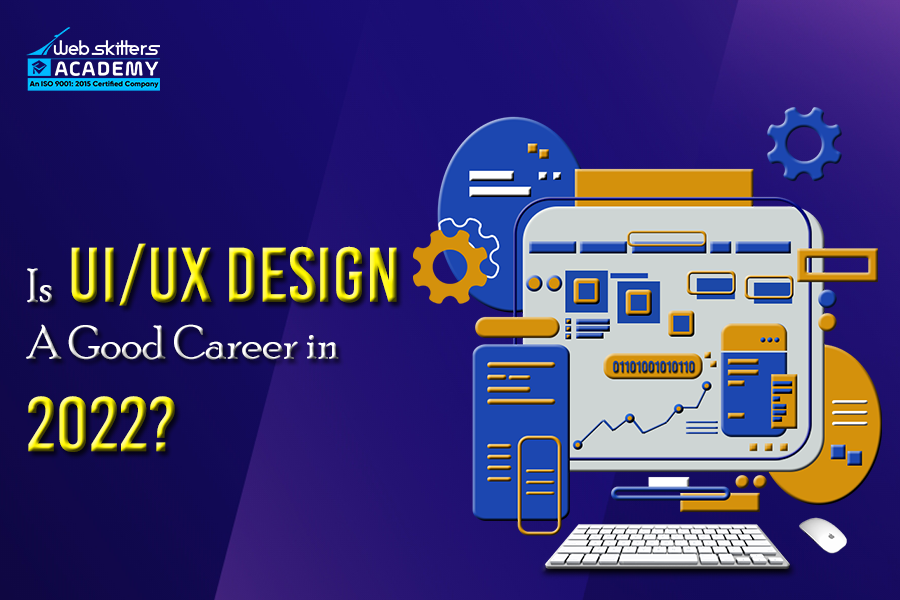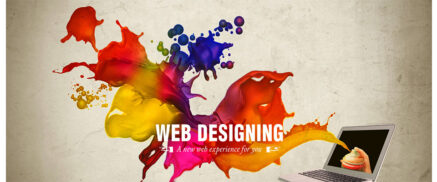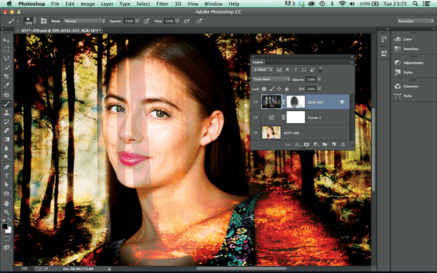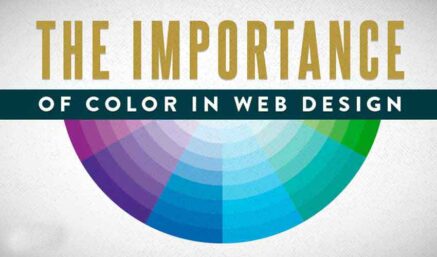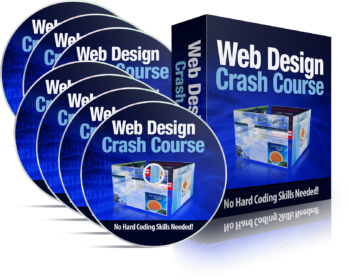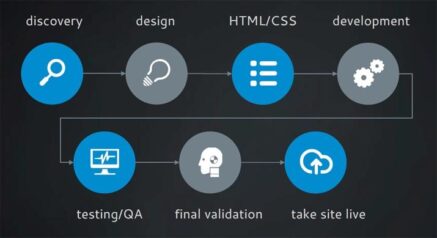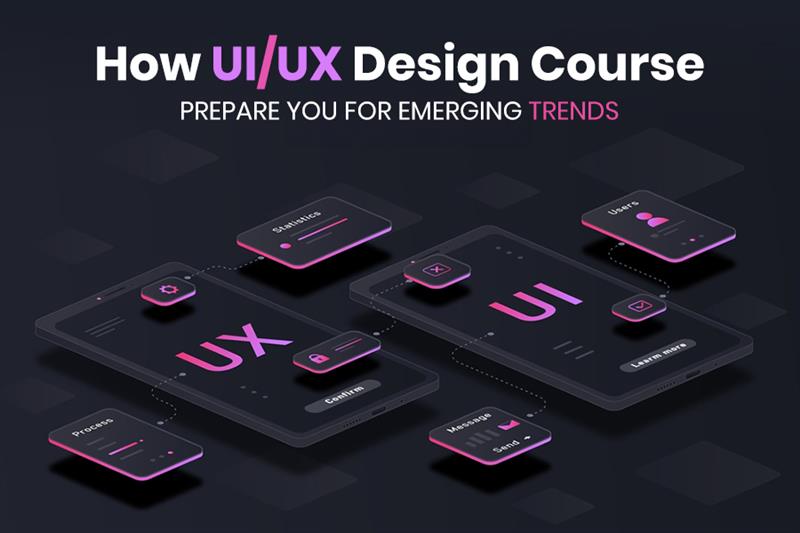
As a UI/UX design enthusiast, you wish to master creating an engaging and appealing user experience.
However, where should you begin?
In the digital age, UI/UX design is essential for creating seamless interactions that captivate users. The rapid growth and development in technology have elevated the value of thoughtful and engaging design cannot. As the demand for seamless digital experiences increases, UI/UX design is now a sought-after profession.
With the rise of mobile applications, smart devices and e-commerce platforms, UI/UX design is no longer an option but a necessity. The modern world requires creative and innovative designers who are adaptable and skilled in tools and UI/UX methodologies.
Are you willing to consider a successful career in this dynamic field? Enrolling in a UI UX design course in Kolkata can be a game-changing step towards your bright future. The goal is to master the essential skills and tools and comprehensively understand design principles under certified mentors.
This comprehensive read introduces the intricacies of UI/UX design courses and guides in excelling as a professional UI/UX design specialist in the market.
Understanding UI/UX Design
User Experience (UX) and User Interface (UI) design are crucial components in the design sphere. They play a critical role in determining the success of a digital product or service. UI/UX design primarily creates engaging and intuitive digital user experiences.
1. UI or User Interface
User interface design focuses on enhancing the visual elements of a digital product. It involves everything the users interact with, from buttons, icons, and typography to attractive colours and impressive layouts.
A professional UI designer helps create a visually appealing interface that offers easy navigation and engagement for users or audiences. Impeccable UI ensures that visual elements align perfectly with the brand identity and maintain functionality.
2. UX or User Experience
User Experience (UX) design comprises the overall experience of interacting with a digital product. UX design makes the user interface active and influential. It is all about making sure people enjoy using digital products effectively.
For instance, user experience design includes an interface with the emotional and psychological responses evoked during interactions. A UX designer’s role comprises research, user testing, and interactive design processes to understand users’ requirements.
Therefore, UX design is about how it feels to use a digital presence or product. A well-curated UI enhances the overall UX and makes it more enjoyable and intuitive.
What UI/UX Design Entails?
In this high-tech world, a strong UI/UX differentiates a product from its competitors and drives engagement and retention. The role of UX design in creating user-centred products includes –
- User Research: UX design conducts studies and surveys to determine user needs, behaviours, and preferences.
- Increased Satisfaction: A well-designed UX provide results with a high user satisfaction rate and strengthens brand loyalty and trust.
- Competitive Advantage: Standard UX design holds the potential to differentiate a product in a crowded market. Additionally, it helps to stand out and retain customers effectively.
- Persona Development: UX design creates a detailed user persona to guide design decisions according to user profiles.
- Usability Testing: The role of UX design also includes testing prototypes with real users. It helps identify pain points and areas for improvement.
- Emotional Engagement: Design experiences that resonate emotionally and prioritise user loyalty and satisfaction.
The UI/UX design process helps maintain the product’s functionality seamlessly on various devices. It enhances usability and accessibility, reinforcing the importance of UX design in today’s digital ecosystem.
The Role of UI/UX Courses in Skill Development
Enrolling in the best UI UX design course in Kolkata will give you several advantages in your career. The course prepares me for a successful career in the dynamic and growing design discipline. Individuals who want to learn can get hands-on experience and expert guidance to create user-centred digital products.
Critical Components of a UI/UX Course
With the help of a comprehensive UI UX design course in Kolkata, students can excel with the essential skills and knowledge to thrive in this field. Essential topics typically covered include:
1. Interaction Design
Interactive design is a crucial topic of the UI/UX design course. This area primarily focuses on designing interactive and innovative elements and understanding how users engage with a product. It is a comprehensive topic that thoroughly understands user behaviour, needs, and preferences. Students learn to create intuitive workflows and enhance usability, ensuring seamless and user-friendly interactions.
2. Wireframing
Wireframing is considered a foundational skill that involves creating low-fidelity sketches of the layout and functionality. This topic helps the learners visualise the product’s structure before moving into the detailed version. Students can learn how to use wireframes as a communication tool to engage with users.
3. Prototyping Tools
In this topic, designers learn how to create interactive models of their designs to test usability and provide feedback. Generally, UI/UX design courses introduce several prototyping tools, such as Figma, Adobe XD, and InVision. These tools enable students to create clickable prototypes that effectively stimulate the final product.
4. Visual Design Principles
The topic ‘visual design principles’ covers the aesthetics of designs. It includes colour theory, typography, and composition. This topic allows students to learn how to create visually appealing interfaces aligned with the brand identity.
Why is Enrolling in a Structured UI/UX Course Vital?
Structured learning through UI/UX courses is crucial to building a solid foundation in design principles and methodologies. A well-organised curriculum ensures every student progresses logically with essential topics and guidance. Design courses bridge gaps in knowledge and allow you to gain adaptive skills. A structured approach ensures enhanced retention and application of concepts in real-world scenarios.
Structured learning through UI/UX courses is crucial for several reasons –
- Foundation of Knowledge: The UI/UX design course provides a solid foundation in design methodologies and principles. The aim is to ensure all students grasp essential concepts before progressing with practical or real-world applications.
- Hands-On Experience: This course includes practical projects and assignments that connect theoretical knowledge. Hands-on experience is vital to apply theoretical concepts in real-world practice to enhance retention and understanding.
- Guided Learning: A well-organised curriculum enables students to progress logically through topics and training. This is the systematic learning approach to bridge gaps in knowledge that arise from self-directed learning.
- Networking Opportunities: Enrolling in this course allows students to connect with industry professionals. Furthermore, it allows students to find suitable jobs, collaborate, and receive mentorship for career start or development.
- Portfolio Development: This project-based course enables students to build a strong portfolio, showcasing their skills to potential employers. This practical experience highlights your capability and creativity to thrive in a competitive job market.
Learning from experienced and qualified instructors offers significant advantages. The instructors bring industry insights and best practices into the curriculum. They implement theory lessons with real-world examples and practice.
Their expertise and knowledge allow students to grasp complex patterns or challenges more efficiently and gain valuable feedback on their work. Additionally, instructors provide mentorship and career guidance essential for the future.
Preparing for Emerging Trends
Staying updated on technological advancements is essential in the design field. This equips designers with relevant skills for the evolving market.
Understanding UI/UX Design Trends
Emerging UI/UX design trends reflect a shift towards cleaner and more user-friendly interfaces. These trends signify a growing focus on user comfort and aesthetic preferences.
Current UI Design Trends:
- Minimalism: This UI design trend emphasises clean lines and ample white space. This is used to enhance usability and focus on the content part.
- Dark Mode: This trend allows you to access visually appealing alternatives that reduce eye strain and conserve battery life on the device.
- Neomorphism: It combines skeuomorphism and flat design, creating soft and inset effects for a more versatile design.
Current UX Design Trends:
- Personalisation: This trend is very effective as it helps to create personalised designs based on needs and preferences. A tailored experience based on user data ensures increased engagement and satisfaction levels through relevant content.
- Voice User Interfaces (VUIs): They enable voice commands to make interactions more convenient and accessible.
- Emotional Design: This trend focuses on creating emotional connections through storytelling and engaging experiences to build brand loyalty.
Emerging trends or technologies address the redefinition of UI/UX design. Artificial Intelligence (AI) integrates with design processes and enables us to acquire intelligent user interfaces. Augmented reality (AR) and virtual reality (VR) create immersive experiences that engage users uniquely.
They transform the way users interact with products and services. These technologies or advancements offer new avenues for creativity and innovation in design.
UI UX design courses are incorporating these technologies and updates into the curriculum. The course provides proper insights and valuable outcomes. The goal is to teach students how to use AI for better user insights and design interactive AR experiences.
Furthermore, these courses prepare designers and creative enthusiasts to meet the industry’s demands effectively and prepare for the future of UX and UI.
Career in UI/UX Design
The job market for UI/UX design is thriving dramatically. The growing emphasis on user-centred digital experiences across industries drives the demand for expert designers.
On completing an advanced UI/UX certification course, the candidate can explore varied job roles –
1. UX Designer
A UX designer is a popular and common role learners explore when completing a UI/UX web design course. They are adept at performing thorough market research and delivering digitally creative interfaces and experiences based on user needs.
UX Designers require adept skills in wireframing and prototyping, as well as the ability to collaborate with other web developers and content strategists.
2. UI designers
UI Designers are responsible for the on-screen appearance of a web presence and work with individual design elements. They focus on developing high-fidelity prototypes indicating how the finished product will appear.
UI Designers are also responsible for user research and analysis and contributing to the cohesive build of the presence.
3. UI/UX Designers
A UX/UI designer fulfils the roles of both a UX and UI designer. While each category prefers separate roles and diverse responsibilities, startups have a combined role for UI/UX designers, who are responsible for handling both ends.
4. UX Manager
They lead the UX team, assign and segregate the job roles, represent the team’s expertise across the company, and ensure projects are completed and deadlines are met.
A UX manager must be skilled in UX design and have prior experience as a UX designer. They focus on coordinating and overseeing projects and staying aligned with trends and best practices.
5. UX Researcher
UX researchers are adept at conducting market research and comprehending user demands. They work with quantitative and qualitative data collected from interviews, user surveys, and A/B tests.
They are responsible for analysing user data and delivering valuable concepts about preferences and the ideal design plan to the experience team.
UX researchers use their high cognitive skills and a strong understanding of human emotions to identify a project’s winning aspects.
Apart from these, several other popular roles, like UI writer, architect, and strategist, have valuable responsibilities in the development, web UI design, and UX cycle. The essential skills for each role include proficiency in design tools like Figma and Adobe XD and a strong understanding of user research. It is necessary to be able to create responsive designs for various devices.
Additional skills in interaction design and information architecture and familiarity with front-end development are advantageous for excelling in this field. Individuals with soft skills like collaboration, empathy, and effective communication also play an essential role.
In summary, education and skill development are crucial for aspiring designers to build their careers.
Practical Skills Gained Through UI/UX Courses
Kolkata’s UI UX design course offers practical skills like user-centred design, experience with industry-standard tools, and research processes. Students engage in project-based learning in this course to enhance their problem-solving abilities. The innovative approach and hands-on experience prepare students for real-world challenges and make them competitive.
Here is a detailed overview –
Hands-on Learning through Online UI/UX Training
Online training programs with Kolkata’s best UI UX design courses offer numerous advantages. Learners get a variety of study materials and forums to enhance their skills.
A structured learning approach encourages valuable learning and fosters a deeper understanding of concepts. Benefits of online UI/UX training include:
- Flexibility: Online training programs allow you to learn at your own pace and schedule. You can easily accommodate your work and personal commitments together.
- Accessibility: Students in online training programs can access a wide range of study materials or resources.
- Diverse Learning Materials: You will use several learning materials formats, such as videos, articles, and interactive assignments.
- Hands-On Experience: Applying theoretical concepts to real-world projects reinforces learning through practical engagement.
- Tangible Outputs: Develop tangible illustrations of your work that effectively highlight your abilities to prospective employers. It is crucial because it demonstrates your competence and capacity to apply your skills in real-world scenarios.
- Industry-Relevant Projects: Engage in tasks that closely resemble real-world industry situations for your development. However, the experience gained through these assignments is invaluable. It will enhance your skills and readiness for the job market.
Tools and Software Used in UI/UX Design
UI/UX design courses introduce students to various tools and software crucial for modern design workflow. Students learn to create interactive prototypes using these tools or software, allowing user testing and feedback.
Some of the popular design tools and software that students learn are mentioned:
- Figma is a cloud-based collaborative design and prototyping tool. It offers powerful vector editing capabilities and design components with a robust plugin ecosystem.
- Adobe XD is a comprehensive design and prototyping software that integrates design, prototyping, and collaboration into a single platform.
- Sketch is a popular interface design tool for MacOS users. It provides a user-friendly interface and powerful vector editing features.
- InVision is an interactive prototyping and user-testing platform that enables designers to create clickable prototypes. It includes tools for learning design handoff and design management systems.
- Adobe Photoshop is software for powerful image editing and graphic design. It is widely used to create impressive visuals, edit photos, and design web layouts.
- Adobe Illustrator is a vector graphics design tool for creating scalable graphics and illustrations. It is the perfect tool for creating logos, icons, and detailed illustrations.
- Lookback is used for usability testing and user feedback. It allows the designers to conduct interviews, user testing, and live feedback sessions, helping students make informed design decisions.
Kolkata’s best UI/UX design course covers all major and minor topics. It also covers a range of UX research methods, such as user interviews, surveys, usability testing, and analytics.
Moreover, students learn how to build research findings into actionable design strategies. The focus is on making the design visually appealing, functional and relevant to users.
Building a Career in UI/UX Design
Building a UI/UX design career involves essential skills, hands-on experience, certifications and more. UI/UX design certifications significantly empower your ability in this field. Your certificates will highlight a commitment to discipline and validate a candidate’s skills and knowledge.
Certificates indicate proficiency level in specific tools, methodologies, and industry standards. Certifications from a recognised organisation, such as Webskitters Academy, are crucial for standing out in the job market.
Furthermore, UI/UX design boot camps focus on equipping students with all practical skills and knowledge in a condensed timeframe. They entail intensive and short-term training programs that enable students to gain hands-on experience in the real world. This approach is practical for making career changes and rapidly gaining relevant skills.
Why is a Strong UI/UX Portfolio Vital?
A strong portfolio is undoubtedly essential to showcase your skills and experience in UI/UX designing. Furthermore, it is a visual resume demonstrating your capabilities and challenges. If you are looking for effective ways to create a compelling portfolio, you need to have a strong command of the given tips –
- Diverse Projects: Include a variety of projects that reflect your skills and experience. For instance, the demand for UI/UX design skills includes user research, wireframing, visual designs, and prototyping.
- Case Studies: For every project, you must give a case study and highlight the design process. You can also mention the challenges faced and how you resolve them. Add user research insights, design iterations, and project outcomes.
- Visual Appeal: Ensure your portfolio is well-designed and visually pleasing. It should follow sound design principles, as it will extend your skills.
- User Experience: While creating your portfolio, ensure it is easy to navigate. To that end, you can easily organise projects responsive to mobile devices. A positive user experience in the portfolio mirrors the commitment of designers. Also, remember that a mobile UI design is a must-have in this smartphone-saturated market.
- Regular Updates: Always update your portfolio with new work and highlight the evolving skills and growth.
By focusing on certifications, boot camps, and a strong portfolio, aspiring UI/UX designers can increase their chances of successful careers.
Enroll in Our UI/UX Design Course Today!
UI/UX design courses significantly prepare students for emerging trends in this industry. It equips learners with skills to create engaging user experiences, ensuring they remain competitive in the job market.
Investing in a UI/UX design course at Webskitters Academy can lead to a fulfilling and rewarding career. With the growing demand for skilled designers across various industries, our graduates are positioned to seize exciting opportunities in tech and beyond.
Individuals looking for quality education get access to explore UI/UX design courses in Kolkata and Durgapur. We are dedicated to our learning approach and offer hands-on training. We encourage you to take the next step in your design journey with us.
Explore the best job-oriented course today!
Search
I Want to Learn...
Category
Explore OurAll CoursesTransform Your Dreams
into Reality
Subscribe to Our Newsletter
"*" indicates required fields
Similar Reads
